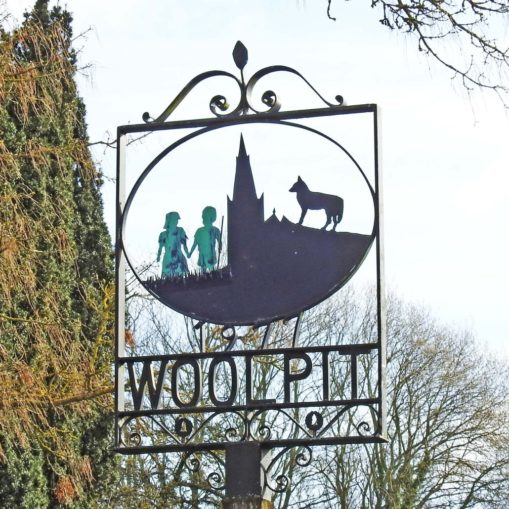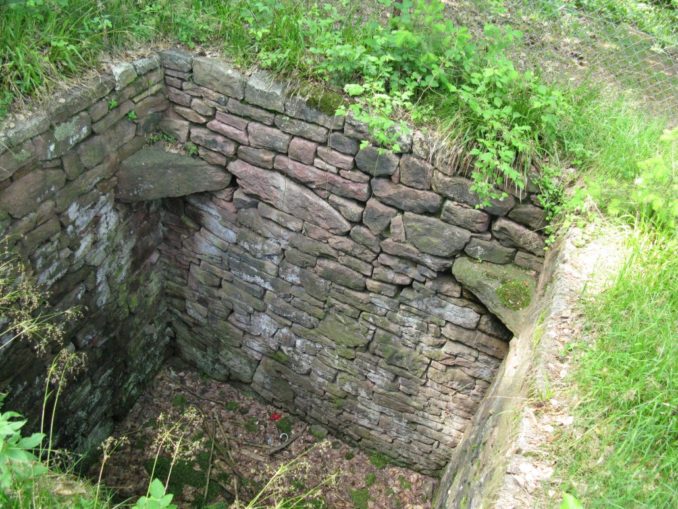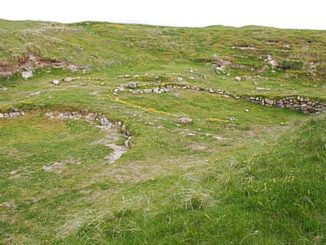
Woolpit village sign by Adrian S Pye, CC BY-SA 2.0, via Wikimedia Commons
Between Bury St Edmonds and Stowmarket in Suffolk lies the small village of Woolpit, named after the ‘wolf pits’ (or traps) which once were said to exist there. These traps took the form of rectangular stone-lined pits or chambers, where carrion would be laid to entice the wolf in, and the top would then be covered over with bracken or other loose vegetation. Once the wolf sniffed the meat, tried to dig for it and fell in, there was obviously no way out. During the middle ages, Woolpit was in a relatively densely populated part of East Anglia belonging to the Abbey of Bury St Edmonds, situated just a few miles away. Here, at some time before the twelfth century, on a fine day in August or maybe September, a very strange thing occurred.
We know it was good weather that day, because the villagers were busily engaged in bringing in the harvest when suddenly two children appeared by the wolf pits. Some said they had scrambled out, but no-one knew for certain. For these were very strange children: they were green-skinned, spoke gibberish and wore odd clothes of unfamiliar design and unknown textiles. Taken to a nearby manor house, where the local lord Sir Richard de Calne of Wykes lived, they refused to eat anything for several days until they suddenly saw some raw broad beans, which they then devoured greedily (having first looked in the stem for the nourishment, then being shown that the beans were actually in the pod). Still no-one could understand a word they said. Yet gradually, as the lord of the manor and villagers took the children under their wing, and taught them some English, a few facts were established. They were brother and sister, they said, and had come from a land called St Martin, where everything was green and the sun never rose to its full height; but the people were contented, they said, with their perpetual twilight (which the children described as being like normal Woolpit days before the sun came up or after it had just set). There was a luminous land they could see in the distance, across a great river, but they had never been able to go there. Neither had any idea how they had arrived in the village: they said they had simply been herding their father’s flocks one day, when they heard a noise like very loud church bells and then suddenly found themselves among the villagers in Woolpit.
The children gradually lost their green skin colouring, and became very like other young people, although the girl – who was taken on as a servant in the lord’s household – was said to be ‘very wanton and impudent’. The boy, who seemed to be the younger, died soon after (or, according to one account, just before) he was baptised; but the girl married, moved to King’s Lynn and apparently had children of her own. The mystery of their origins remained just that – a mystery.

Georg Waßmuth.The original uploader was Geowas at German Wikipedia.; transfer made by Claus Ableiter, CC BY-SA 3.0 DE, via Wikimedia Commons
Their story was told to the world by two mediaeval chroniclers , Ralph of Coggeshall (in Essex, about thirty miles away) in the thirteenth century and William of Newburgh (from Yorkshire) in the twelfth. William said the girl was still living just before he wrote his account. The tale waxed and waned, but eventually became very popular as people took up the curious circumstances and reworked them into drama, literature and folklore (if that is not what they were already). The legend may even have spread further afield: there is a version of it set in Spain, where they are called the green children of Banjos. In this telling, the children lived underground in a cavern with two suns (hmmm), when one day their home was inundated with water and they swam through the cave mouth to find themselves in an unknown location above ground, which they had never dreamed existed.
So what could underlie the story? Some commentators have seen it as an early representation of alien beings (‘little green men’), especially as one report said they ‘fell from heaven’. Could they have come from some other dimension? It goes without saying it seems unlikely – something only science fiction would portray – although I think from memory Graham Hancock considers something like this in his book ‘Supernatural’, where he examines the properties of the drug ayahuasca in opening doors to other levels of consciousness. Were the children, alternatively, dyed green and told to play a role, as a prank? Could they, maybe, have even dreamed up such a scheme themselves? Who can say. There is however a medical condition called chlorosis, a type of anaemia historically known as ‘the green sickness’, which can go away in time with proper nutrition – as is said to have been the case here. Chlorosis can be caused by deficiency of vitamin B6 due to low iron intake, diminished iron absorption, or excessive iron loss. It can also be caused by infections resulting from hookworm infestation, copper toxicity, lead poisoning, severe stomach or intestinal bleeding or haemorrhoids. The condition reached a peak in the nineteenth century (mainly, it seems, among enervated young women) then apparently died away, being last reported in the 1930s.
Another theory holds that perhaps the children of Woolpit had been poisoned with arsenic (which temporarily coloured their skin) before being taken to nearby woods – some said Thetford Forest – where they were either left to their fate, or escaped their captors and ran. Having lived in the thick woods might possibly explain the pervasive green-ness and lack of sunlight they reported in their environment.
One explanation, however, seems much more plausible. Historian Paul Harris says the children could have been from a Flemish colony of weavers which had formed in a village north of Bury St Edmunds called Fornham St Martin. The Flemish colony itself is factual. Harris suggests that if their parents were indeed Flemish clothworkers who settled there, the whole community could have been the subject of reprisals in 1173, when Fornham was the site of a battle during the civil war between King Henry II and his son known as the ‘Revolt’. Rebel forces led by the Earl of Leicester, together with a large number of Flemish mercenaries, landed in Suffolk and were defeated on the banks of the river Lark. The Flemish mercenaries were all slaughtered, and it is not hard to imagine what the potential repercussions of that might have been for any Flemish inhabitants nearby. Maybe some of them were even involved, or had connections to others who were. Maybe the children fled their own community during the subsequent chaos, or were carried off and abandoned after their parents were killed, harmed or driven off. This might account for their strange clothing, disorientation and unfamiliar language, but hardly for the green skin! On the other hand, clothworkers would certainly have had access to dyestuffs, including green, which was a popular colour at the time. However, William of Newburgh says the appearance of the children among the harvesters of Woolpit took place c. 1150, in the reign of King Stephen, or around twenty-three years before the battle of Fornham. Again, an explanation which raises more questions than it answers.
During the 1970s, according to Wikipedia, a folk singer from Suffolk called Bob Roberts apparently said he had been told there were still people in Woolpit who claimed to be descended from the green children, but nobody would tell him who they were!
© foxoles 2025



